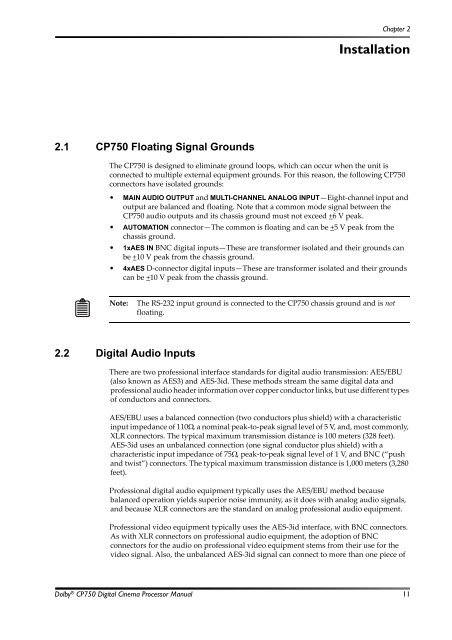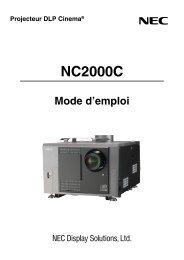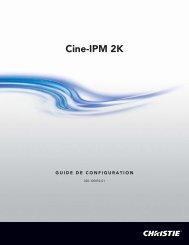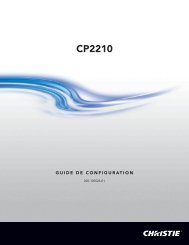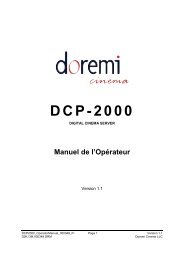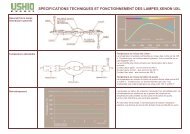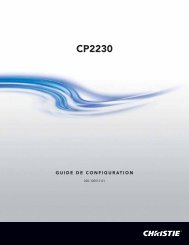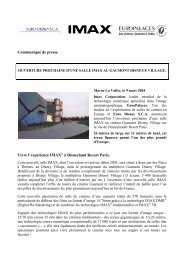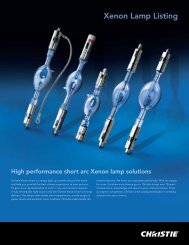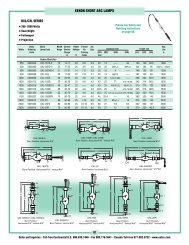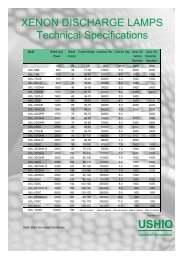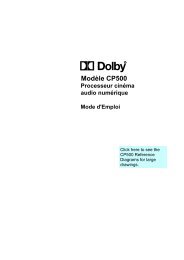Dolby CP750 Digital Cinema Processor Manual - Projectionniste.net
Dolby CP750 Digital Cinema Processor Manual - Projectionniste.net
Dolby CP750 Digital Cinema Processor Manual - Projectionniste.net
You also want an ePaper? Increase the reach of your titles
YUMPU automatically turns print PDFs into web optimized ePapers that Google loves.
Chapter 2<br />
Installation<br />
2.1 <strong>CP750</strong> Floating Signal Grounds<br />
The <strong>CP750</strong> is designed to eliminate ground loops, which can occur when the unit is<br />
connected to multiple external equipment grounds. For this reason, the following <strong>CP750</strong><br />
connectors have isolated grounds:<br />
• MAIN AUDIO OUTPUT and MULTI-CHANNEL ANALOG INPUT—Eight‐channel input and<br />
output are balanced and floating. Note that a common mode signal between the<br />
<strong>CP750</strong> audio outputs and its chassis ground must not exceed +6 V peak.<br />
• AUTOMATION connector—The common is floating and can be +5 V peak from the<br />
chassis ground.<br />
• 1xAES IN BNC digital inputs—These are transformer isolated and their grounds can<br />
be +10 V peak from the chassis ground.<br />
• 4xAES D‐connector digital inputs—These are transformer isolated and their grounds<br />
can be +10 V peak from the chassis ground.<br />
Note:<br />
The RS‐232 input ground is connected to the <strong>CP750</strong> chassis ground and is not<br />
floating.<br />
2.2 <strong>Digital</strong> Audio Inputs<br />
There are two professional interface standards for digital audio transmission: AES/EBU<br />
(also known as AES3) and AES‐3id. These methods stream the same digital data and<br />
professional audio header information over copper conductor links, but use different types<br />
of conductors and connectors.<br />
AES/EBU uses a balanced connection (two conductors plus shield) with a characteristic<br />
input impedance of 110, a nominal peak‐to‐peak signal level of 5 V, and, most commonly,<br />
XLR connectors. The typical maximum transmission distance is 100 meters (328 feet).<br />
AES‐3id uses an unbalanced connection (one signal conductor plus shield) with a<br />
characteristic input impedance of 75, peak‐to‐peak signal level of 1 V, and BNC (“push<br />
and twist”) connectors. The typical maximum transmission distance is 1,000 meters (3,280<br />
feet).<br />
Professional digital audio equipment typically uses the AES/EBU method because<br />
balanced operation yields superior noise immunity, as it does with analog audio signals,<br />
and because XLR connectors are the standard on analog professional audio equipment.<br />
Professional video equipment typically uses the AES‐3id interface, with BNC connectors.<br />
As with XLR connectors on professional audio equipment, the adoption of BNC<br />
connectors for the audio on professional video equipment stems from their use for the<br />
video signal. Also, the unbalanced AES‐3id signal can connect to more than one piece of<br />
<strong>Dolby</strong> ® <strong>CP750</strong> <strong>Digital</strong> <strong>Cinema</strong> <strong>Processor</strong> <strong>Manual</strong> 11


